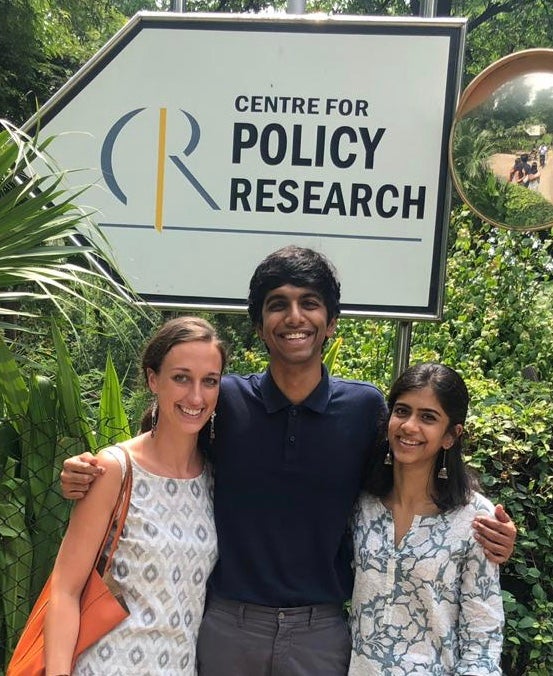Rachel Leeds
This summer I had the honor of working at the Centre for Policy Research (CPR), one of India’s leading public policy think tanks. Founded in 1973, CPR is a non-profit, non-partisan independent institution dedicated to conducting research that contributes to the production of high-quality scholarship, better policies, and a more robust public discourse about the structures that shape life in India. Their team of faculty, fellows, and research assistants work on a range of topics including economic policy, environmental law, international relations and security, regulation and state capacity, and urbanization.

I came on to work with Rahul Verma, a Fellow who specializes in voting behavior and party politics. He is establishing a research program at CPR to focus more explicitly on Indian politics and democracy and I had the opportunity to help his team develop the foundation and framework for this program. The program will explore deliberative democracy at the local level; political participation of women, minorities, and disadvantaged groups; youth engagement in politics; and the political consequences of the social, economic, and cultural transformations that have been unfolding over the last few decades in India.
More than 600 million people cast their votes in the 2019 Lok Sabha election – India’s highest turnout to date. My first task at CPR was to take a closer look at voter turnout in the Banda District of Uttar Pradesh. In the 2014 election, the average turnout in Banda was 53%. For this election, the district magistrate launched a campaign to reach an ambitious target: 90% turnout. Hundreds of volunteers were mobilized to reach out to voters directly and encourage them to vote, and a slew of posters, social media content, and cultural events reinforced the importance of voting and provided information on how and where to vote. As a result, turnout increased to 63%. The electoral data revealed some other interesting trends: turnout was consistently higher among women (and in regions where migrants represent 35% or more of the electorate, the difference in turnout between men and women was even greater) and turnout was higher at smaller polling stations (as measured both by number of booths per polling station and number of electors per polling station).
Examining the increase in voter turnout in Banda prompted another question: what else has changed in terms of political participation and perception in Banda over the last decade? To begin to answer this, I used the India Human Development Survey , a nationally-representative survey that was first conducted in 2005 and again in 2012. Looking at indicators that address topics such as confidence in institutions, membership in political organizations and community groups, welfare benefits, trust, and conflict, I compared responses from both years among all respondents versus those from Uttar Pradesh and, more specifically, those from Banda. Among respondents in Banda, those reporting a great deal of confidence in politicians increased from 4% in 2005 to 57% in 2012. Confidence in the police and state government also dramatically increased. As a next step, we will be developing some models to determine which of the IHDS indicators might have the highest predictive power for participation in local village assemblies.
Banda is one of 725 districts in India, which are further divided into 5,500 blocks, and 250,000 panchayats (administrative clusters of villages). The Accountability Initiative , an organization that was founded by CPR in 2008, aims to strengthen transparency and accountability at all levels of service delivery. However, the disaggregation of data varies from one source to the next, and often depends on the scheme or state. I searched as many online, publicly available datasets as possible to compare their formats and units of analysis to help the Accountability Initiative determine the most efficient way to consolidate the data to ultimately map the delivery of services down to at least the panchayat level (if not the village level).
Finally, one of the best advantages of being based at CPR was the access to a wide variety of fascinating events, talks, and guest lectures. During my stay, I was able to participate in a closed-door workshop with several leading political economists, journalists, and members of parliament about what the 2019 elections mean for the future of the BJP and the future of Indian politics more broadly. I also attended lectures on the characteristics of politicians that increase their responsiveness to citizen demands, state effectiveness, key policy challenges for the current administration, the 2019-2020 Union Budget, women’s mobilization in campaigns and elections in Delhi, and universal basic income. Not only was each speaker a leader in their field, but the rooms were full of similarly passionate and knowledgeable experts which further enriched the discussions. These events reinforced the important role a think tank plays in convening academics and practitioners to discuss the latest research and how it can be applied to new policies or projects. Over the course of eight weeks, India revealed itself to me in an endlessly enthralling array of experiences. From my first rickshaw to my last metro ride, becoming part of the ebb and flow of Delhi’s 20+ million people was fascinating and unforgettable. Jawaharlal Nehru likened India to “…some ancient palimpsest on which layer upon layer of thought and reverie had been inscribed, and yet no succeeding layer had completely hidden or erased what had been written previously.” My understanding of India is still limited to the thinnest of layers at the very surface, but what I have learned makes me eager to uncover more. I am forever grateful to those who helped me peel back those first few layers, especially Rahul, Amisha, Tanvi, and Harish. Thank you for making my first trip to India so delicious, educational, enchanting, and fun – I look forward to discovering more of your incredible country soon.